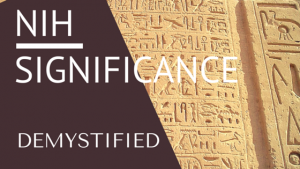 One of the great things about working with some top scientists to hone their grant-getting skills is that I get to hear really good questions that they struggle with.
One of the great things about working with some top scientists to hone their grant-getting skills is that I get to hear really good questions that they struggle with.
One question from a client was this:
“I am a bit confused about what goes in the Significance and the Innovation sections of my proposal, and how those are different from the Approach.”
In my grant writing programs like the Grant Foundry, I teach the concept of posing “problem-solution” pairs. These pairs always come together, and I often see failures in grants because people present solutions without problems, or problems without solutions.
All great grant proposals are framed around a series of problems, from the big to the more specific, along with a series of potential solutions, as yet unrealized… until you get the grant money to make those solutions move forward.
It sounds simple, and in theory, it is. Yet it’s hard to do in practice – at least judging by the people I work with at top universities.
To answer this question, I’ll assume that you “get it” and are going to implement the problem-solution framework in your grant.
Once we have that framework, the answer to this question is simple:
- The Significance section is about the problem(s) –
- why are they important?
- whom do they impact?
- why is a solution currently missing?
- what have people tried? (be brief with this, don’t do a literature review)
- why is a solution needed now?
- what has happened that makes you think you and your team have a solution? (in broad terms – leave the specifics for later)
- in which aim will you solve which problem?
- why is your team qualified to solve the problem(s)?
- The Innovation section is about the solution(s), but from the specific angle of “what’s new and different about your solution that makes it viable?” In other words:
- what advance has happened to make your solution potentially likely to work?
- what new enabling ideas or technologies does it use?
- what new approaches do you use?
- how are you combining existing approaches in a new way?
- what unique resources have you developed or have access to?
In the Innovation section, we’re not trying to cover the entire solution. We are only discussing what’s new and useful about the solution(s) that are going to be offered in the Approach section. A mistake is to provide reams of detail here – save that for the Approach.
As always, you should use great sub-headers to break up the text, and compelling figures for both your Significance and Innovation sections to illustrate the problem(s) and the new solution(s).
Once you’ve got that covered, that leaves us with the Approach section. The Approach is more about your solution. In the Approach section you simply detail the “recipe” you’ll use to make the solution happen – along with evidence that shows you are competent to do it, and that it will likely work (i.e. preliminary data). I cover more on that elsewhere in the blog.
So, remember:
- Significance = problem and
- Innovation = what’s new about the solution
It can be complicated to master these concepts at first. I understand it as I walked the same path of discovery and struggle when it came to grant proposals. That is why I want to bring you a fast, simple and very focused on-demand training that will help you discover the 3 Deadly Myths of Scientific Grant Writing (and how to avoid them by understanding them). The best part? it is totally free, dive in here

3 replies to "The NIH Significance and Innovation Sections: demystified"
Great blog post Morgan.
This is transferable one for one to the business world. We all do not want to be told what we already know. We want to understand first the significance of the issue at hand and define it this for me or not and than we want to understand the new, different, innovative way of going about solving the issue before we spent time to dive deeper into the actual approach, e.g. the solution.
Hey Tom- Thanks for the comment! And, yes, this is definitely a transferable skill. Grants are very much like “direct marketing” in the business world. You’re using words to “sell” a project… just like a business person must use words ultimately to sell a product.
While there are some specifics of grant proposals that make it a bit different, the same skills apply.
So, yes, very good to first build the “significance” then the “innovation” then finally the “approach” in your sales processes!
Cheers!
funding acceptances/levels are so low. But we must all persevere. The system is awful, the grant game is a nonstop bureacracy , crazy making, computer system fails/overloads, forms, docs, letters, bios, body, addenda, but we must all persevere. However, given all of this crazy making, it may be better to seek other opportunities because life is too short.